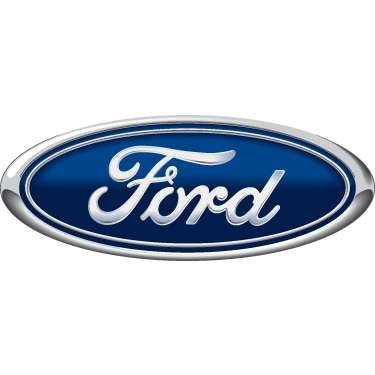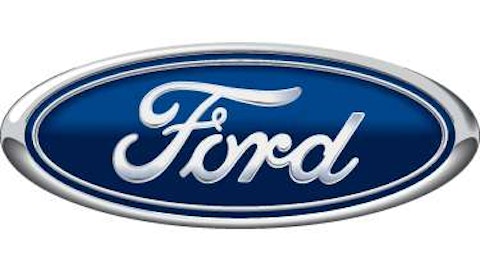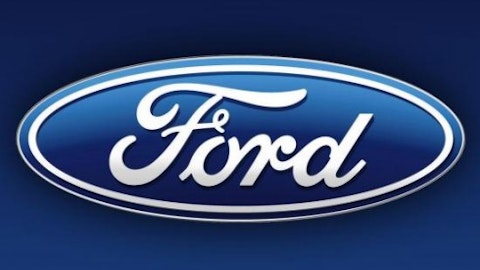If you follow Ford Motor Company (NYSE:F) closely, you’ve noticed the quick rise in price over the past few months. It’s natural to get the feeling that after such an increase, it’s due for a pullback. That may or may not be the case, as it’s futile to try to predict the market. That said, it’s important to keep the big picture in mind, and even after such a price run-up, Ford is still worth investing in. I’ll list out two simple factors that will be entirely responsible for Ford’s stock soar closer to $20 a share. That could happen sooner than you might think.
Top line
Let’s start with the top-line sales, which Ford must continue to increase to stay competitive with the global sales leader, Toyota Motor Corporation (ADR) (NYSE:TM). In fact, I read the other day that the three competitors expected to compete for the title of global sales leader were Toyota, General Motors Company (NYSE:GM), and Volkswagen. Ford was left off the short list, which must change sooner rather than later for the automaker. This year, Ford has some things lined up that should help propel its top-line growth. The nation’s best-selling vehicle, the F-Series truck, is still selling strong at a time when truck sales are rebounding and expected to grow more as construction spending increases.
Ford is also anticipating strong sales numbers from the popular Fusion and Escape for 2013, since this will be the first full year of sales for the redesigned models and both offer consumers great value in popular vehicle segments. Both vehicles also take advantage of the emerging fuel-efficiency demand. Consider that the Escape, an SUV, gets 23 miles per gallon in the city and up to 33 on the highway. I was impressed by those numbers. I still remember when typical SUVs barely got half that mark.
Still, that doesn’t matter much if the company can’t bring home profits on the bottom line. It’s obvious that if you want the stock price to increase, revenues have to increase first. That leads me to why I’m so confident with Ford compared with GM. Take a look at each company’s trailing 12 months of revenue, and the costs of that revenue.
| Metric | Ford | GM |
|---|---|---|
| Revenue | $132,404 | $150,939 |
| Cost of Revenue | $110,865 | $132,546 |
| Gross Profit | $21,539 | $18,393 |
Figures in millions.
Profits
You can see the difference in cost management between the two companies right off the bat. If Ford is able to bring more profits in with less top-line revenue, imagine what it can do if it grows revenue by 20% over the next few years. Alan Mulally’s “One Ford” plan has created a corporate culture focused on operating efficiency, and it’s evident in a bulging bottom line.
Here’s an example of one stat no one hears about, as Birgit Behrendt, head of global programs and purchasing for the Americas, told Automotive News:
“We have been reducing the global number of production suppliers from 3,300 in 2004 to about 1,260 at year-end 2012. We have identified plans that will take us to about 750 suppliers globally, and we are confident that our consolidation efforts will result in a stronger and healthier supply base.”
Trimming the production suppliers that drastically will not only have a good impact on the bottom line, but it will also increase Ford’s leverage. The amount of parts in the vehicle won’t change, and when suppliers are consolidated, it means a larger piece of the pie for each supplier. That, in turn, means more companies will fight for each of Ford’s production budget, causing production costs to decrease.
This all clearly aligns with the first bullet point of the “One Ford” plan: Aggressively restructure to operate profitably at the current demand and changing model mix.
Along with sharply reducing the amount of global suppliers, Ford is decreasing its amount of vehicle platforms. Right now, Ford’s plan is to trim the number of platforms that all of its vehicles are made on down to nine by year’s end. The plan also aims to have 85% of global sales come from these platforms. Ford is attacking efficiency at every possible angle, and this approach will ensure that bottom-line profits will increase quickly with top-line growth.
Bottom line
Ford’s goal is clear: to be the most efficient profit-producing machine on the planet. It’s on track to do so by following Alan Mulally’s vision. The most important thing for Ford is to increase its revenue by selling into emerging markets and cashing in on its popular vehicles in North America. With the profitable U.S. market surging, Ford has a great opportunity to grow its revenues over the next few years. It’s already extremely efficient, and it will only become more so as cost reductions continue to play out. When revenues increase, the bottom line and stock price will surely follow.
Don’t be afraid of the stock price’s recent run-up. Ford still has a lot of room to run.
The article 2 Things for Ford’s Stock to Keep Soaring originally appeared on Fool.com and is written by Daniel Miller.
Fool contributor Daniel Miller owns shares of Ford. The Motley Fool recommends Ford and General Motors and owns shares of Ford.
Copyright © 1995 – 2013 The Motley Fool, LLC. All rights reserved. The Motley Fool has a disclosure policy.






